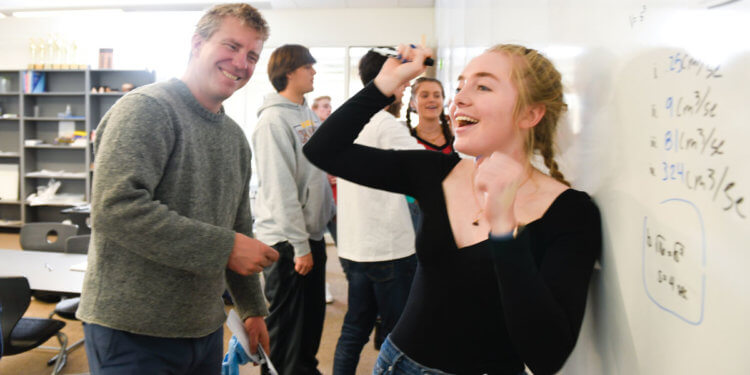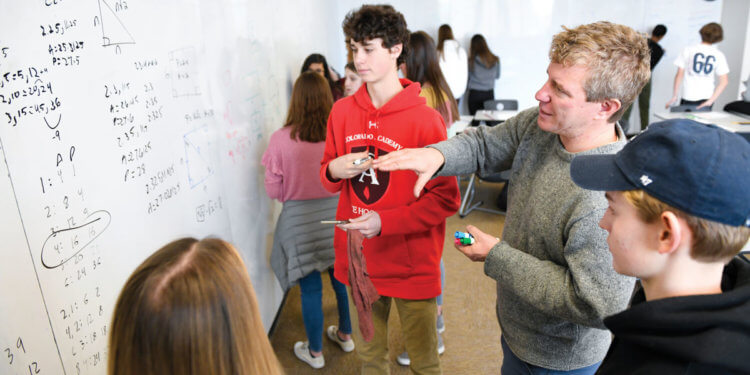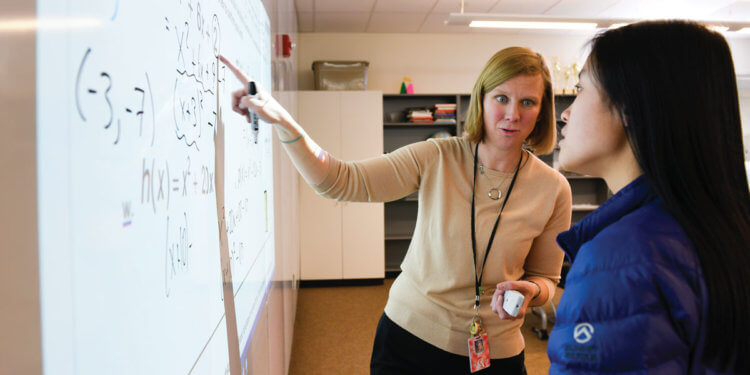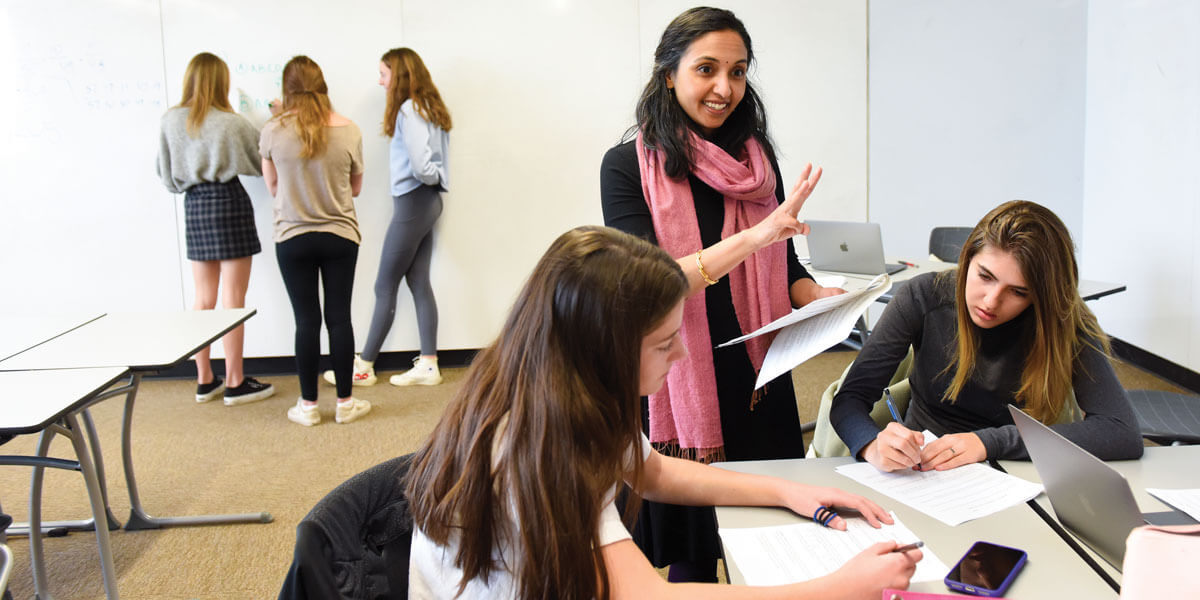Jane Doherty ’19 is really enjoying college, but she has a confession—she misses math at Colorado Academy. A Freshman at Georgetown University majoring in neurobiology, Doherty will have plenty of opportunity to practice the math she learned at CA in collegiate statistics and calculus courses. But she feels prepared for any future challenge because of the years she spent at CA in what she calls a “numerical playground,” where she gained “a deep love for math.”
“The way we learned math reflected the fact that the subject is not just a collection of equations to be memorized,” she says. “Rather, CA allowed me to appreciate math for the awesome thing that it is—an entire system that leverages small known patterns to solve for large unknowns.”
Doherty describes CA’s approach to teaching math as “exploratory” and “investigative.” And that approach, she readily admits, occasionally led to moments of frustration.
“When new material was introduced in class, we weren’t just handed equations, which would’ve required much less time and brain power,” she says. “Instead, we were expected to manipulate mathematical patterns we already knew to solve unfamiliar problems, which takes much longer and is a lot harder.”
What Doherty may not have fully realized during her years at CA was that the frustration she felt and the occasional struggles she had with math were not accidental. They were a deliberative part of the curriculum for Upper School students, where Chair of the Mathematics Department Peter Horsch says teachers look for a balance between struggle and success as students develop their math skills.
“I like hearing students say, ‘I’m not sure, but here’s what I am thinking,’” Horsch says. “We want students to take on problems they are not sure they know how to do, perhaps struggle, perhaps not get to a final result, but they persevere. And ultimately they see even the struggle is rewarding.”

Math in Ninth Grade
Step into Horsch’s Math 1 class, a combination of algebra and geometry, and you may feel as though you have taken a wrong turn. The students are seated in small groups of four, talking quietly to each other, as if they might be discussing the themes of a classic novel. Instead, they are talking math.
Horsch floats from group to group offering feedback. You never hear him say the words “that’s right” or “that’s wrong.” Instead, you hear this:
“What mathematical evidence supports your conclusion?”
“Your answer is good, but how do we know it’s right?”
“What was your process here?”
Students take new problems and migrate with their small groups to whiteboard walls, where they can fill the perimeter of the classroom with numbers, arrows, fractions, and different approaches to solving a problem. At this point, the class becomes an aerobic exercise for Horsch as he bounces on cross-trainers around the room from group to group, coaching their mathematical thinking, smiling all the time. “I love watching and listening to students doing math,” he says. “I know that it’s a tool that will allow them to understand their world, whether they go into business, engineering, design, medicine, scientific research, art, or even teaching.”
Some groups of students join others to view their thinking. No one gives up. Horsch moves around the room, reviewing their whiteboard work and asking questions.
“I’m not convinced, are you?”
“That looks like a hard strategy. I wonder if there is another approach?”
“That’s excellent. But does it really work?”
Suddenly, Ninth Grader Dori Beck is jumping up and down at the whiteboard. “Five works! Five works! I can tell you why! Can we have more problems?” It is a classic “Aha!” moment.
Beck explains what prompted the celebration. “There are different ways to approach a problem, and Mr. Horsch is interested in how we as a group worked together, using different viewpoints, to get to an answer,” she says. “You start to learn why things don’t work; there is a lot of trial and error involved, and when you get it, it’s rewarding.”
For Ninth Grader Hudson Parks, new to CA in his Freshman year, this approach to learning math is a departure from middle school. “I was used to having a lecture, taking notes, practicing the problem for homework, then taking the test,” he says. Parks describes the approach at CA as more “interactive,” with communication among students and between a student and the teacher. “It’s actually easier for me to learn,” he says. “It’s just more helpful to know why and how you got the answer, because you can build on that mathematical thinking.”
By the time the students hit the third round of problems in the class, they look like athletes who have spent the first period of the game warming up and now are ready to play. They come to their final challenge with speed and focus. Horsch keeps up the questions and concludes with affirmation.
“This was really good work today. We were not just doing the math, but getting better at providing mathematical evidence. We were thinking about the process and finding ways of simplifying it so something that took seven steps might only take two steps.”

The method of teaching
Horsch likes to use an analogy to explain how his approach to teaching math has evolved over the years. Decades ago, he would show how a problem was solved, ask the students to practice it, and then perform what they learned on a test. It was, he says, a lot like a music recital or a play, where students practice and then perform. But with time and teaching experience, he came to believe that math was better viewed as a theatrical improvisation, inventing a play on the fly or as sight reading, playing music you have never seen before.
“What that may mean is that your math may not be as polished as a recital or play for which you have practiced,” he says. “You may miss a note or a line, and students have to understand that’s okay.”
Using this approach means that students are more actively involved in building their own understanding of math concepts. The peer groups they work in are chosen randomly, with no teacher’s hand manipulating who works with whom. “The students learn from each other and they know I don’t control the group,” Horsch says. “The groups are not labeled by ability, which emphasizes that everyone has something to contribute.” What all the students know is that they cannot look to Horsch for the answer. In response to a question, they are likely to get another question: “How did you get there? Will this work again? Why do you think that?”
“From teaching a concept and then practicing the math, we have flipped it,” Horsch says. “We introduce the problem first and ask students to discover the underlying concept.”
Upper School Principal Dr. Jon Vogels compares this approach to the way science classes have been taught for many years. “You might start with a hypothesis in your science lab and do an experiment,” he says. “When your lab doesn’t work, you would have to analyze why and try again.”
For individual students who might learn differently, Horsch adjusts his methods. Also, some math lessons are not driven by discovery. Instead, he teaches in a more explicit way, engaging in targeted deliberate practice. Again, Horsch likes an analogy to explain why a mix of discovery and practice helps a student learn. “If you play tennis, hitting the ball fed by a machine can be really helpful, but if that’s all I do, I won’t be prepared for a tennis match,” he says. “In real play, a ball can come at a different angle, height, or spin.” In short, students need both experiences—practice and discovery—the ball machine and the competition—to best learn the game.
The value of struggle
For some students, the challenge of solving a problem they have never seen before and explaining their process—the equivalent of improvising or sight reading—may feel uncomfortable. Horsch likes to point out that it’s not unlike the struggles competitive athletes go through at any level. Increasingly, education writers are addressing the concept of struggle, particularly in math. Jo Boaler, the Nomellini-Olivier Professor of Education at Stanford, wrote about academic struggle in a recent article, excerpted here:
“As parents and teachers, we do just about everything we can to make sure that children don’t struggle. It turns out we are making a terrible mistake. Research shows that struggling is absolutely critical to mastery and that the highest achieving people in the world are those who have struggled the most.
“Neuroscientists have found that mistakes are helpful for brain growth and connectivity and if we are not struggling, we are not learning. Not only is struggle good for our brains but people who know about the value of struggle improve their learning potential. This knowledge would not be earth shattering if it was not for the fact that we in the Western world are trained to jump in and prevent learners from experiencing struggle.
“When I was teaching middle schoolers in a research math camp a few years ago one girl stood out to me; she was nearly always wrong in her thinking, but she was always engaged, arguing her case, pushing to understand better. An observer of the class would have described her as a low achiever, but she improved more than any other of the 84 students we taught that Summer. Her standardized test score in mathematics improved by 450 percent after 18 struggle filled lessons. Our messages to the students—that struggle would be valued and mistakes are productive—had helped her feel good about struggle and embrace it.
“Millions of students start the school year each year excited for all they will learn, but as soon as they struggle or see someone solve a problem with ease, they start to doubt themselves and mentally shut down. This starts a less productive learning pathway for them. Instead they should value the time of struggle and know that they are on their way to being better, wiser and equipped with a stronger brain.”
In Paul Tough’s book The Years That Matter Most: How College Makes or Breaks Us, he profiles Uri Treisman, PhD, who received a MacArthur Fellowship recognizing his work in math education. On his first day in Freshman calculus at the University of Texas-Austin, Treisman tells his students, “Everybody in this class will struggle. No matter who you are, questions are going to be flying at you that you can’t answer. And when that happens, you’re going to experience stress…. But in fact, that stress is an indicator that your understanding is deepening. It’s not a sign that you’re not learning. It’s a sign that you are learning.”

Twelfth Grade calculus
The Twelfth Grade calculus class co-taught by Horsch and Erin Gray is an example of learning in action. The two teachers had a number of their Senior students when they were Freshmen in Math 1. They have seen the students grow both in their mathematical knowledge and their view of themselves as creators of mathematical knowledge. “Their willingness to engage with difficult tasks and the success they have is one of the most rewarding parts for me of teaching this class,” says Gray. “The continuity that we, as teachers, can maintain from Freshman year to Senior year speaks to the advantages of being at a small school like CA.”
Senior Andersen Dodge describes math as “probably not my strongest subject,” and yet she really likes coming to class because of the one-on-one time she receives from teachers. Her classmate, Senior Seb Parra, also admits that math is probably not his “favorite” subject, but he chose to take calculus because he wants to major in business in college and he believes that being able to take derivatives of functions will help him as a young entrepreneur.
Like the Math 1 class, Horsch and Gray circulate from one randomly assigned group to the next, coaching and asking questions. It’s a very different approach to calculus than Gray remembers from her days as a student. “My teacher had an overhead projector and he would work a problem or two,” she says. “We sat in rows, took notes, and then we practiced the problems.” But, she says, if you looked at the topics in calculus that she studied, her students are learning the same content, except the learning is driven by student discovery. “This is a shared experience driven by student work,” she says. “And the students have to be effective communicators about their mathematical work. That’s what prepares them for careers where they will need to work on diverse teams.”
“There’s no doubt this is a challenging way to teach,” Vogels says. “It demands both preparation and flexibility.”
Gray agrees. “To a casual observer, it may look like we are winging it, but we have come up with problems that point students in a particular direction, and there is always an element of surprise that requires flexibility, creativity, and communication among students and teachers.”
She is convinced this approach serves CA students well, because it helps students build a deeper and longer lasting understanding of math. “Students retain the things they figure out better than the things they are told,” she says. “You don’t want to have to memorize a formula for everything you do in math class, because memorizing doesn’t guarantee storage. A deep flexible understanding of a concept—that’s the bigger win.”
In the calculus class, you hear those wins from students as they work problems.
“Wow, that’s crazy!” exclaims one student. Another chimes in, “That feels like magic!”
“No, not magic,” Horsch says. “It’s magical.” Later he explains what he means.
“Working through a math problem isn’t magic, like something behind the curtain you don’t understand,” he says. “It’s magical, because it’s fantastic how it all fits together.”
For Jane Doherty, the magical experience of CA math continues in college. “This way of learning ultimately increased my confidence so much, because I learned how to be mathematically self-reliant, resilient, and cognitively flexible,” she says. “I learned that one’s abilities as a mathematician are measured best by how they can puzzle through new challenges by using prior foundational information and patterns. I’m so thankful for the Math Department at CA.”
